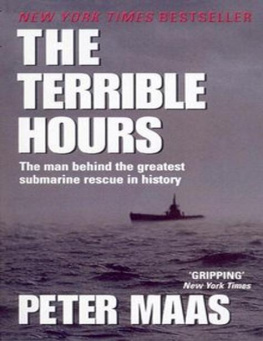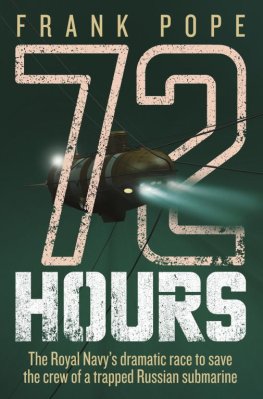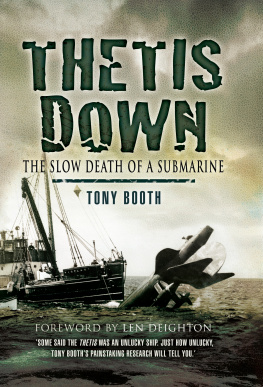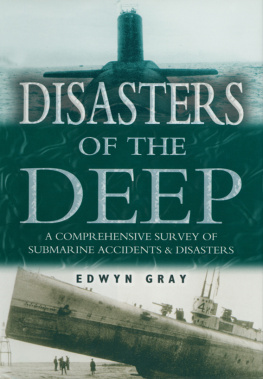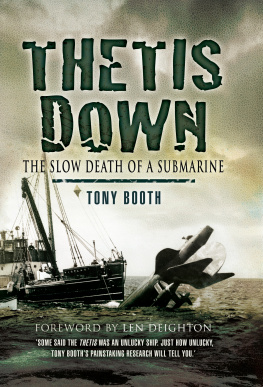Peter Maas - The Terrible Hours: The Greatest Submarine Rescue in History
Here you can read online Peter Maas - The Terrible Hours: The Greatest Submarine Rescue in History full text of the book (entire story) in english for free. Download pdf and epub, get meaning, cover and reviews about this ebook. year: 2011, publisher: Ebury Publishing, genre: Detective and thriller. Description of the work, (preface) as well as reviews are available. Best literature library LitArk.com created for fans of good reading and offers a wide selection of genres:
Romance novel
Science fiction
Adventure
Detective
Science
History
Home and family
Prose
Art
Politics
Computer
Non-fiction
Religion
Business
Children
Humor
Choose a favorite category and find really read worthwhile books. Enjoy immersion in the world of imagination, feel the emotions of the characters or learn something new for yourself, make an fascinating discovery.
- Book:The Terrible Hours: The Greatest Submarine Rescue in History
- Author:
- Publisher:Ebury Publishing
- Genre:
- Year:2011
- Rating:3 / 5
- Favourites:Add to favourites
- Your mark:
- 60
- 1
- 2
- 3
- 4
- 5
The Terrible Hours: The Greatest Submarine Rescue in History: summary, description and annotation
We offer to read an annotation, description, summary or preface (depends on what the author of the book "The Terrible Hours: The Greatest Submarine Rescue in History" wrote himself). If you haven't found the necessary information about the book — write in the comments, we will try to find it.
Peter Maas: author's other books
Who wrote The Terrible Hours: The Greatest Submarine Rescue in History? Find out the surname, the name of the author of the book and a list of all author's works by series.
The Terrible Hours: The Greatest Submarine Rescue in History — read online for free the complete book (whole text) full work
Below is the text of the book, divided by pages. System saving the place of the last page read, allows you to conveniently read the book "The Terrible Hours: The Greatest Submarine Rescue in History" online for free, without having to search again every time where you left off. Put a bookmark, and you can go to the page where you finished reading at any time.
Font size:
Interval:
Bookmark:
Contents
On the eve of World War II, the Squalus , America's newest submarine, plunged to the bottom of the North Atlantic. Miraculously, thirty-three crew members still survived in the stricken vessel. While their loved ones waited in unbearable tension onshore, their ultimate fate would depend upon one man, US Navy officer Charles Swede Momsen an extraordinary combination of visionary, scientist and man of action. In this thrilling true story, prize-winning author Peter Maas vividly re-creates a moment-by-moment account of the disaster and the man at its centre. Could he actually pluck those men from a watery grave? Or had all his pioneering work been in vain?
Mr. Maas proves once again there is little he
cannot achieve with the written word.
New York Times Book Review
Peter Maas has established himself as one
of the nations most respected nonfiction authors.
Pittsburgh Post-Gazette
Peter Maas offers insights only the
best reporters can unearth.
Boston Globe
Each time I pick up Maas, I feel that I have been
given a backstage pass to an American moment.
Los Angeles Times Book Review

In memory of an extraordinary man, Swede Momsen,
whose likeness rarely passes our way.
The world, so to speak, began with the sea, and who knows but that it will also end in the sea!
C APTAIN N EMO , in Jules Vernes
Twenty Thousand Leagues Under the Sea
IT WAS A Tuesday, May 23, 1939.
In New York City, Bloomingdales department store was promoting a new electronic wonder for American homes called television.
With great fanfare, United Airlines began advertising a nonstop flight from New York to Chicago that would take only four hours and thirty-five minutes.
In baseball, a young center fielder for the New York Yankees named Joe DiMaggio was headed for his first major league batting title.
The film adaptation of the novel Wuthering Heights, starring the English actor Laurence Olivier in his first hit movie, was in its sixth smash week.
Another novel destined to become an American classic, Nathanael Wests portrait of Hollywood, The Day of the Locust, was dismissed in the New York Times as cheap and vulgar.
In Canada, the visiting British monarchs, King George VI and Queen Elizabeth, met the Dionne quintuplets for the first time.
In London, Ambassador Joseph P. Kennedy advised an association of English tailors that they would never gain a foothold in the American market unless they stopped making trouser waistlines too high and shirttails too long.
In Berlin, as Europe teetered on the brink of war, Hitler and Mussolini formally signed a military alliance between Germany and Italy with a vow to remake the continent. In Asia, meanwhile, Japan had finished another week of wholesale carnage in China.
THAT TUESDAY MORNING, in the picture-postcard sea-coast town of Portsmouth, New Hampshire, with Federal architecture and cobblestone streets dating back to the late eighteenth century, Rear Admiral Cyrus W. Cole, commandant of the Portsmouth Navy Yard, the nations oldest, received a group of visiting dignitaries. Cole was a peppery little man with an imposing head and a piercing gaze that made him seem larger than he actually was. Although not a submariner himself, he had a particular affinity for the men who manned the Navys pigboats. His only son served on one, and before coming to the Portsmouth yard, which specialized in submarine construction, Cole had commanded the Navys underseas fleet. Now he liked to wisecrack, They sent me back to see how theyre built.
When one of his visitors asked the admiral if he thought the United States might be drawn into the looming conflict in Europe, he said he hoped not. If it proved otherwise, though, any enemy would rue the day.
You hear a lot about those German U-boats, he declared, but they couldnt compare with the submarines that the Portsmouth yard was sending down the ways. This very afternoon the newest addition to the fleet, the Squalus, would return to her berth after a series of test dives. He promised a tour, so they could see her for themselves.
Squalus? What kind of name is that?
Cole confessed that hed had to look it up. Its a species of shark. A small one. But with a big bite, he added, smiling.
Then Cole passed his visitors over to Captain Halford Greenlee, the yards industrial manager. Their arrival, arranged at the last minute, had forced Greenlee to cancel plans to go down to the overnight anchorage of the Squalus and board her that morning. Greenlee had been especially looking forward to it. His son-in-law, Ensign Joseph Patterson, was the subs youngest officer.
Sorry you couldnt go out with her today, Cole said.
Its not the end of the world, Greenlee replied. I can always catch her another time.
TWO REPORTERS FOR the Portsmouth Herald at the yard on assignment for other matters were the first outsiders to hear the news. After frantically gathering whatever scraps of information were available, they raced back to the paper.
Minutes later, just past two P.M., the first stark, bell-ringing bulletin clattered over Associated Press teletypes to newspapers and radio stations throughout the country:
SUBMARINE SQUALUS DOWN
OFF NEW ENGLAND COAST
THE PORTSMOUTH NAVY Yard occupied an island three miles upstream from the mouth of the Piscataqua River, a twisting, tidal millrace that separated New Hampshire and Maine. To avoid contending with the Piscataquas seven-foot highs and lows during which an ebb current could reach a full twelve knots, the Squalus, after a day of training exercises, had remained overnight in a rockbound cove near where the river emptied into the North Atlantic.
The wife of her skipper, Lieutenant Oliver Naquin, had decided to give their two young children a special treat. In the late afternoon, she had driven down from Portsmouth to the cove where the Squalus stretched low in the water behind an ocean breakwater. But Naquin had the crew busily engaged in internal housekeeping preparatory to an anticipated inspection when the sub returned to the yard, and when they arrived, nobody was in sight to answer their shouts and waves. Frances Naquin often thought of this during the terrible hours that lay ahead.
THE SQUALUS WAS the Navys newest fleet-type submarine, 310 feet long, twenty-seven feet wide, displacing 1,450 tons. Her rated surface speed was sixteen knots. On battery power, while submerged, she could do nine knots. Seemingly, every care and precaution had been lavished on her. She was state-of-the-artand deadly. Topside along her length she had a slotted teakwood deck. Above the deck rose an oval steel island some twenty feet high with a big 192 painted in white on each side. It was officially called the bridge fairwater, more popularly known as the conning tower.
It also had two hydraulically operated valves that functioned on the same principle as ordinary faucets. Named the high inductions, one was an opening thirty-one inches across that fed air to her four 1,600-horsepower diesel engines when she cruised on the surface. The other, sixteen inches in diameter, ventilated the boat. Mounted on the deck as well was a three-inch gun to finish off crippled targets or for use as a last resort to fight off an attacking enemy ship.
Next pageFont size:
Interval:
Bookmark:
Similar books «The Terrible Hours: The Greatest Submarine Rescue in History»
Look at similar books to The Terrible Hours: The Greatest Submarine Rescue in History. We have selected literature similar in name and meaning in the hope of providing readers with more options to find new, interesting, not yet read works.
Discussion, reviews of the book The Terrible Hours: The Greatest Submarine Rescue in History and just readers' own opinions. Leave your comments, write what you think about the work, its meaning or the main characters. Specify what exactly you liked and what you didn't like, and why you think so.

